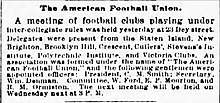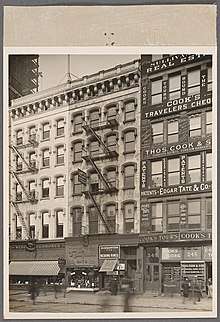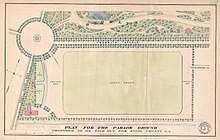American Football Union
The American Football Union (AFU) was a coalition of amateur, semi-professional, and collegiate club football teams that operated from 1886 to 1895 in the New York metropolitan area. Although the minor league was practically inconsequential and obscure in the development of professional American football, the Orange Athletic Club, who participated in the league from 1888 to 1895, would go on to become the Orange and Newark Tornadoes, and join the NFL for two seasons in 1929 and 1930.[1]
| American Football Union | |
|---|---|
| AFU | |
| Established | January 6, 1886 |
| Dissolved | 1895 |
| Members | 5–8 (start), 2–4 (final), 10–17 (total) |
| Sports fielded |
|
| Region | Eastern |
| Headquarters | New York City, New York |
| Commissioner | Clarence M. Smith (1886 and 1887-?) |
History
Founding


On January 6th, 1886, representatives from several different athletic institutions across the New York metropolitan area met at 23 Dey Street in Manhattan to discuss the plausibility of a new athletic association for the sport of football. These institutions were the Staten Island, New-Brighton, Cutler, Stevens Institute, Polytechnic Institute, Brooklyn Hill, Crescent, and Victoria football clubs. The delegates of these eight athletic clubs eventually voted to form the association known as "The American Football Union". An election was held, and C. M. Smith of the Staten Island Cricket Club was chosen as the first AFU president. William Denman won secretary, and W. Ford, E. P. Moorton, and R. M. Ormiston were appointed to the Executive Committee.[2][3]
The second meeting for the fledging football association was held at 3:00 p.m. on the following Wednesday at the same site, and was focused on laying down a series of rules for the league to adopt. A committee composed of R.M Ormiston, H. C. Staniland, and H. Waldo Jr., who were the captains of the Polytechnic, Victoria, and New-Brighton athletic clubs respectively, were chosen to draft the new rules for the union. Other developments of note were arrangements for a schedule of conference matchups for the upcoming football season, as well as a trophy for whichever club won the most in-league games. A new rule was established that if any club failed to make an appearance within half an hour of their scheduled contest, they would have to forfeit the contest to the opposing team.[4][5] The Brooklyn Hills and Cutler's school delegates were absent, and the Stevens Institute sent in a letter of resignation from the Union.[6]
1886 season
The AFU's first fall meeting was held on September 31st at No.243 Broadway Street, and welcomed representatives from the five institutions who confirmed their teams for the 1886 season. They were the Unions of Columbia College, Brooklyn Hill Football Club, Cutler School, the Spartan Harriers, and the Staten Island Football Club. The Staten Island Football Club was a consolidation of three clubs on Staten Island, the Athletic, Cricket, and Rowing associations, as well as the Clifton Athletic Club. William Halsey of the Brooklyn Hills was appointed the new secretary of the AFU, and the annual dues for membership were set at $10 (roughly $275 in 2020).[7][8]
Although the first contest between two members of the AFU occurred on October 10th, [9]the first AFU sanctioned football game took place on October 16th with the Brooklyn Hills Football Club against the "Crickets of Stevens" (Stevens Institute Secondary team) at 3:30 p.m. on St. George's Cricket grounds in Hoboken, New Jersey. The Crickets won 22–6, but disputed calls by the referee resulted in the contest coming under review of the AFU Executive Committee.[10]
For the 1886 season, the plan was for each of the representative teams to play each other twice, and whoever recorded the most wins would be given the Union pennant as champion of the league.[11] However, much Turmoil persisted around membership in the early AFU that strained this requirement. The Polytechnic Institute attended the first two meetings of the AFU but opted out of league-play because of an apparent lack of strength in their team.[12] The New York Athletic Club was in negotiations with the Executive Committee but never committed to the $10 fee, and the Nassau Athletic Club applied for the Union and was denied.[13][14] Although the Crescent Athletic Club was a founding member of the Union, they would not be considered a member for the 1886 season. The reason for this is unknown, but their was some speculation that the Athletic Club was too strong for the new organization, with the team composed of many Yale Alumni. On October 19th it was reported that the Spartan Harriers were withdrawing from the AFU effective immediately, and the Polytechnic Institute was to pick up the Harriers' schedule. It's unclear, but unlikely, that the Institute followed this request.[15] The Cutlers, who had not played a single team in the AFU all season, resigned on October 24th, with Brooklyn Hills appointed to play their remaining opponent, the Staten Island Football Club. The Hills would tie the club team 0–0 on November 13th, [16] Three days later, Brooklyn Hills would hold a club meeting and resign from the organization as well, citing an inability to complete their present schedule and frustration over having too many Saturday's without a conference matchup. By the end of the season, the AFU was composed of only three teams, the Crickets of the Stevens Institute, the Unions of Columbia College, and the Staten Island Football Club. A year later, this resignation would be blamed on an "unfair decision in a disputed game", which would elude to either their November 6th forfeit win or disputed loss to the Crickets on October 16.[17]
At the first meeting of the new year, held in the office of AFU president Clarence Smith, the Crickets of Stevens Institute were officially and unanimously awarded the championship pennant for the 1886 season.[18][19] The Crickets had compiled a 3–0 record in official league contests, and outscored their opponents by a total of 35 to 22. F. S. Sevenoak of the Crickets Club was elected as the new secretary and treasurer of the league after the resignation of William Halsey of the Brooklyn Football Club.[20]

1886 Standings
| Conf. Rank | Team | Overall record | Conf. record | PPG | PAG |
|---|---|---|---|---|---|
| 1 | Crickets of Stevens Institute | 3–0 | 4–1 | 11.4 | 5.6 |
| 2 | Staten Island Football Club | 1–2–2 | 2–3–3 | 2.5 | 7.75 |
| 3 (tie) | Brooklyn Hill | 0–1–2 | 3–5–3 | 6.45 | 12.91 |
| 3 (tie) | Unions of Columbia | 1–2 | 1–3 | 7 | 5.75 |
| 5 (tie) | Cutler School | 0–0 | #–# | # | # |
| 5 (tie) | Spartan Harriers | 0–0 | 0–0 | 0 | 0 |
Key
PPG = Average of points scored per game, PAG = Average of points allowed per game
1887 season
The Crescent Athletic Club was officially admitted to the AFU as a full member in April of the 1887 season.[21] They would become the most dominate team in the Union over the next five seasons. A team was also formed by the Staten Island Cricket and Baseball Club[22], after spending a year consolidated in the Staten Island Football Club (and any players that were in the football club were then amalgamated in the cricket club)[23][24]. The last addition for the season was the New York Athletic Club, which entered the league to replace the Crickets of Stevens, who may have combined with the Unions of Columbia in mid-October.[25][26] The Unions would last for a month before folding themselves, with some sources claiming that the team did so because of their abysmal league record.[27] At a meeting on November 21, the AFU officially recognized the Crickets resignation from the league, but stated that the Unions of Columbia College's resignation was still "laid out on the table".[28]
With a 6–0 record, and having not allowed a single point against them in AFU competition[29], the Crescent Athletic Club was officially awarded the championship pennant and the title of "Metropolitan champion" (in relation to the New York metropolitan area). The meeting for the ceremony was held at No 243 Broadway, in the office of Union President Clarence Smith, and was attended by representatives from the Crescent Athletic Club and Staten Island Cricket Club. The AFU was adjourned until Friday, March 7th.[30] It's unclear if there was one championship pennant that changed hands every time a new champion was crowned, or if the AFU had a new championship pennant for each season of competition. [31]
1888 season
Members
| Institution | Location | Founded | Nickname | Years in AFU | Notes |
|---|---|---|---|---|---|
| Boston Athletic Association | Boston, MA | 1887 | 1893–1894? | ||
| Brooklyn Hill Football Club | Brooklyn, New York | Brooklyn Hills | 1886 | The Brooklyn Hills left the AFU mid-season because of a disputed call that defined the score of a league game. There was some discussion of them rejoining the Union for the 1887 season but this never materialized. | |
| Clifton Athletic Club | Cliftons | 1886 (Consolidated) | The Clifton Athletic Club was a founding member of the AFU, and was consolidated into the Staten Island Football Cub for the 1886 season. | ||
| Crescent Athletic Club | Bay Ridge, Brooklyn, New York | 1884 | Crescents | 1886 (DNP), 1887–1895 | The Crescents were a founding institution of the AFU, attending the meetings that created the Union and ratified the league by-laws and constitution. However, they would not participate |
| Crickets of Stevens Institute | Hoboken, New Jersey | 1870 | Crickets | 1886, 1887 (Consolidated?) | The Crickets were 1886 champions, but either consolidated with the Unions of Columbia College or disbanded entirely for the 1887 season. |
| Cutler School | Manhattan, New York | 1876 | Cutlers | 1886 (DNP) | The Cutler school was a founding member and signed on for the 1886 season but never played a league opponent. |
| Elizabeth Athletic Club | 1895? | ||||
| Manhattan Athletic Club | Manhattan, New York | 1877 | 1891? | ||
| New Jersey Athletic Club | 1895? | ||||
| New York Athletic Club | Manhattan, New York | 1868 | 1887–1893 | There were negotiations between the Executive Committee of the AFU and the NYAC for the 1886, but the club did not ultimately join the league until the next season. | |
| Orange Athletic Club | Orange, New Jersey | 1887 | Oranges/Tornadoes | 1888–1895 | |
| Polytechnic Institute of Brooklyn | Brooklyn, NY | 1853 | 1886 (DNP) | The Polytechnic Institute was a founding member, but decided not to play in the AFU for the 1886 because of their belief that their football team was not at the same level as the other members of the Union. | |
| Spartan Harriers | Manhattan, NY? | Harriers | 1886 (DNP) | The Spartan Harriers were not a founding member, but joined the Union briefly for the 1886 season before dropping out in late October with a 0–0 record. They were most likely an organization based primarily on running, and sponsored a few moonlight-chases for Brooklyn in 1886, but not much else is known. | |
| Staten Island Athletic Club | West Brighton, Staten Island, New York | 1886 (Consolidated), 1887 | The Staten Island Athletic Club was a founding member of the AFU, but were consolidated into the Staten Island Football Club for the 1886 season. It's possible that the club was consolidated again in the 1887 season for the Staten Island Cricket Club. | ||
| Staten Island Cricket Club | Livingston, Staten Island, New York | 1866 | 1886 (Consolidated), 1887–1890 | The Staten Island Cricket Club may have been a founding member of the AFU, with the list of clubs mentioning a "Staten Island" team, which could have been any of the three athletic clubs on the Island. | |
| Staten Island Football Club | Staten Island, New York | 1886 | Islanders | 1886 | The Staten Island Football Club was not an independent organization, but rather an amalgamate of four separate athletic associations, the Staten Island Athletic Club, Staten Island Rowing Club, Staten Island Cricket Club, and Clifton Athletic Club of New York. They would be disbanded for the 1887 season, and any players that wished to continue with the AFU were combined into the Staten Island Cricket Club. |
| Staten Island Rowing Club | Staten Island, New York | 1886 (Consolidated) | The Staten Island Rowing Club may have been a founding member of the AFU, and was consolidated into the Staten Island Football Cub for the 1886 season. | ||
| Union Club of Columbia College | New York City, New York | 1754 | Unions | 1886, 1887 | The Unions resigned from the AFU midway through the 1887 season, with some reporting that the team was tired of losing. It's also possible that the team was disbanded to focus efforts on Columbia's freshmen football team, which was the only team left to represent the college for the 1887 season (Columbia did not have a Varsity football team between 1885 and 1889). |
| Victoria Athletic Club | New York City, NY? | Victorias | 1886 (DNP) | The Victorias were a founding member of the AFU, but did not play for the league in their inaugural season. It's unlikely that they even fielded a football team. | |
- DNP stands for "did not play", as the football club had some association with the Union but did not play in their championship series'.
American Football Union champions
References
|